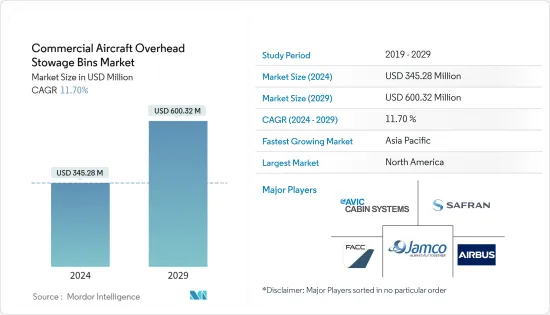
민간 항공기용 오버헤드 수납함 시장 규모는 2024년 3억 4,528만 달러로 추정되며, 2029년에는 6억 32만 달러에 달할 것으로 예상되며, 예측 기간(2024-2029년) 동안 11.70%의 CAGR을 기록할 것으로 예상됩니다.

오버헤드 수납함은 도입 이후 모션 컨트롤과 수납성 측면에서 먼 길을 걸어왔습니다. 디자인은 승객의 기내 반입 수하물의 종류와 양, 그리고 더 큰 용량에 대한 수요에 따라 진화해 왔습니다. 항공사들은 더 많은 여행객들이 편안하게 여행할 수 있도록 기내 공간을 최대화하는 데 초점을 맞추고 있으며, OEM들은 항공사들과 긴밀히 협력하여 승객들의 수요에 맞는 더 크고 가볍고 아름다운 디자인의 새로운 오버헤드 빈을 개발하고 있습니다. 이러한 개발은 또한 항공사에 프리미엄 수납 옵션을 통해 추가 수익을 창출할 수 있는 기회를 제공합니다.
오버헤드 수납함은 모든 민간 여객기에 장착되어 있어 여객기 이용률 증가로 인한 승객 수 증가와 함께 신규 항공기 인도 증가에 따라 수요가 증가하고 있습니다. 제조업체가 항공사와 승객의 진화하는 요구에 부응하기 위해 노력함에 따라 새로운 항공기 프로그램과 객실 개조 프로젝트가 시장 성장의 원동력이 될 것으로 예상됩니다.
그러나 탑승 이륙 시간이 단축됨에 따라 많은 항공사가 체크인용 수하물 시설만 도입하는 추세로 항공기 내 보관함에 대한 항공사의 수요는 감소하고 있습니다.
와이드 바디 항공기는 이동 시간이 긴 장거리 및 국제선 항공편에 주로 선택됩니다. 이러한 여행에서 승객들은 대형 기내 반입 수하물을 포함하여 더 많은 수하물을 휴대하는 경향이 있습니다. 따라서 항공사들은 와이드바디 항공기의 넉넉한 오버헤드 수납공간을 활용해 이러한 여행객들의 수납 수요를 충족시키고 있습니다. 와이드 바디 항공기는 더 넓은 좌석 배치와 더 큰 오버헤드 수납공간을 제공하도록 설계되어 보다 편안하고 안락한 기내 경험을 제공합니다. 만족도가 높은 승객은 편안함의 요구를 우선시하는 항공사를 선택하는 경향이 있습니다. 예를 들어, A350에서 영감을 얻은 에어버스 A330neo의 머리 위 수납공간은 크게 확대되었습니다. 더 많은 수하물을 보관할 수 있도록 66% 더 많은 공간이 추가되었습니다. 프리미엄 캐빈에서는 A330neo의 넓은 환경을 증폭시키기 위해 중앙 수납공간을 설치하지 않았습니다. 에어버스 A350은 대형 오버헤드 수납공간을 갖추고 있어 승객들이 더 많은 수하물(모든 클래스에서 승객 1인당 최소 1개의 롤러백)을 수납할 수 있어 스트레스 없이 탑승하고 비행 중에도 쉽게 접근할 수 있습니다.
보잉은 B737MAX 기종에 옵션으로 스페이스 빈(Space Bin)을 제공하고 있습니다. 스페이스 빈은 표준 사이즈의 수하물을 6개까지 수납할 수 있으며, 이는 현재 B737NG 일부 기종에 장착되어 있는 대형 보잉 스카이 인테리어 피벗 빈보다 2개 더 많은 용량입니다. 전 세계 여러 항공사의 와이드바디 항공기 주문이 증가함에 따라 더 많은 수납함의 수요가 늘어날 것으로 보입니다. 예를 들어, 2023년 5월 에어인디아는 보잉에 B787 드림라이너 20대, B777X 10대, 에어버스에 A350-1000 34대, A350-900 6대 등 총 70대의 와이드바디 항공기를 주문했습니다.

아시아태평양에서는 중산층 인구 증가, 가처분 소득 증가, 관광 산업 확대 등을 배경으로 항공 여행이 크게 증가하고 있습니다. 이러한 승객 수의 증가는 기내 반입 수하물 증가에 따른 머리 위 수납함의 수요 증가와 직결됩니다. 아시아태평양은 가까운 장래에 항공 시장에서 높은 성장률을 기록할 것으로 예상됩니다. 국제항공운송협회(IATA)에 따르면, 2030년까지 아시아 지역의 항공 여객 수는 북미와 유럽을 능가할 것으로 예상됩니다. 이러한 여객 수송량의 높은 성장률에 따라 이 지역의 항공사들은 수요 증가에 대응하기 위해 새로운 항공기를 조달해야 합니다.
또한, 아시아태평양 항공사들은 운항 효율성과 승객 만족도를 높이기 위해 항공기 구매와 현대화에 점점 더 많은 투자를 하고 있습니다. 이러한 현대화에는 오버헤드 수납함을 포함한 객실을 최신 편의성 및 미적 기준에 맞게 업그레이드하는 것도 포함됩니다. 중국, 인도, 일본, 한국 항공사는 항공기 확장 및 현대화 프로그램의 일환으로 항공기 OEM에 협동체 및 와이드바디 항공기를 대량 주문하고 있습니다. 예를 들어, 보잉은 2021년 2월 인도 하이데라바드 공장에서 타타 그룹과의 합작회사인 타타 보잉 에어로스페이스 리미티드(TBAL)의 B737 MAX 제품군의 복잡한 수직 꼬리날개를 생산하기 위한 새로운 제조 라인을 설치한다고 발표했습니다. 또한 2023년 2월 현재 에어 인디아, 인디고 등 인도 민간 항공사는 각 항공기 제조업체에 1,100대의 항공기 주문을 보류하고 있습니다. 항공기 주문과 납품이 증가함에 따라 예측 기간 동안 이 지역에서 오버헤드 수납함에 대한 수요가 동시에 발생할 가능성이 높습니다.
민항기 오버헤드 수납함 시장은 통합되어 있으며 Airbus SE, FACC AG, Safran, AVIC Cabin Systems(UK) Limited, JAMCO Corporation과 같은 주요 기업이 있습니다. 이들은 민간 항공기용 오버헤드 수납함 및 관련 부품 제조업체 중 일부입니다. 새로운 항공기 모델 도입에 따라 혁신적인 솔루션과 제품을 제공할 수 있는 기업은 장기적인 계약을 체결할 수 있는 이점이 있습니다. 또한 항공기 OEM이 자체적인 오버헤드빈 개발 및 설계에 대한 투자를 늘리는 것은 오버헤드빈 제조업체 세계 시장 점유율에 어느 정도 영향을 미칠 수 있습니다. 예를 들어, 에어버스는 2023년 6월 A220 제품군 고객에게 새로운 객실 기능을 갖춘 새로운 에어스페이스 캐빈을 제공하기로 결정했습니다. 이에 따라 딜 항공은 A220 기종에 새로운 오버헤드 빈과 도어 부분을 개발할 가능성이 높습니다. 에어스페이스 XL 빈이라고 불리는 A220용 Diehl의 새로운 오버헤드 빈은 수납 용량이 20% 증가합니다. 경량화된 Airspace XL 오버헤드빈은 또한 처리 시간을 단축하고 전체 기내 구조물의 무게를 약 300파운드 줄임으로써 기내 구조물의 무게를 줄여줍니다.

The Commercial Aircraft Overhead Stowage Bins Market size is estimated at USD 345.28 million in 2024, and is expected to reach USD 600.32 million by 2029, growing at a CAGR of 11.70% during the forecast period (2024-2029).
Overhead stowage bins have come a long way since their introduction in terms of motion control and storability. The design has evolved with the type and quantity of passenger carry-on baggage and the demand for increased bin capacities. Airlines are focusing on maximizing cabin space to accommodate more travelers comfortably. OEMs are working closely with airlines to develop new overhead bins that are large, lightweight, and aesthetically designed to suit passenger demands. These developments also provide airlines with opportunities to generate additional revenue through premium storage options.
Overhead stowage bins are provided on every commercial passenger aircraft, and hence, their demand is increasing with the increasing deliveries of new aircraft as an increasing number of passengers are taking to the skies, leading to higher aircraft utilization rates. New aircraft programs and cabin refurbishment projects are expected to drive market growth as manufacturers strive to meet the evolving needs of airlines and passengers alike.
However, in accordance with decreasing the boarding deplaning time, many airlines are promoting only check-in luggage facilities in their airlines, which offers a decrease in demand from such airlines for storage bins in the aircraft.
Widebody aircraft are predominantly chosen for long-haul and international flights, which are characterized by extended travel times. Passengers on such journeys tend to carry more luggage, including larger carry-on items. Consequently, airlines rely on the generous overhead storage capacity of widebody aircraft to meet the storage needs of these travelers. Widebody aircraft are designed to offer more spacious seating arrangements and larger overhead bins, contributing to a more comfortable and relaxed in-flight experience. Satisfied passengers are more likely to choose airlines that prioritize their comfort needs. For example, Airbus' overhead storage for the A330neo, inspired by the A350, is substantially larger. It offers an additional 66% space for more luggage. In the premium cabin, there is no center stowage installed to amplify the spacious environment of the A330neo. Airbus A350 features large overhead storage compartments; passengers can store more hand luggage - a minimum of one roller bag per passenger in all classes - for stress-free boarding and easier access in flight.
Similarly, Boeing offers its Space Bins as an optional feature on its B737MAX aircraft. Space bins can hold six standard-sized bags, which is two more than the large current Boeing Sky Interior pivot bins installed on several B737NGs. An increase in widebody aircraft orders from various airlines across the globe will likely fuel the demand for more storage bins. For instance, In May 2023, Air India placed orders for 70 widebody aircraft, including 20 B787 Dreamliners and 10 B777Xs from Boeing, as well as 34 A350-1000s and six A350-900s from Airbus.

Asia-Pacific is witnessing a significant surge in air travel, driven by a burgeoning middle-class population, increased disposable income, and expanding tourism. This growth in passenger numbers directly correlates with higher demand for overhead storage bins, as more travelers carry cabin luggage. The Asia-Pacific region is expected to achieve a high growth rate in the aviation market in the near future. According to the International Air Transport Association (IATA), air travel in Asia will be greater than the next two biggest markets, North America and Europe, by 2030. With such a high rate of growth in terms of passenger traffic, the airlines in the region need to procure new aircraft to cater to the increasing demand.
Moreover, Airlines in the Asia-Pacific region are increasingly investing in purchasing and modernizing their aircraft fleets to improve operational efficiency and passenger satisfaction. Part of this modernization includes upgrading the cabin, including overhead storage bins, to meet the latest standards in convenience and aesthetics. The airlines in China, India, Japan, and South Korea have huge order books for narrow-body and wide-body aircraft to aircraft OEMs as a part of fleet expansion and modernization programs. For instance, in February 2021, Boeing announced a new production line at the Hyderabad facility (India) of its joint venture with the Tata Group, Tata Boeing Aerospace Limited (TBAL), to manufacture complex vertical Fin for B737 MAX family aircraft. Moreover, as of February 2023, Indian private airlines such as Air India, Indigo, and others have 1,100 pending aircraft orders from various aircraft manufacturers. With the increasing aircraft orders and deliveries, simultaneous demand is likely to be generated for overhead stowage bins from this region during the forecast period.
The commercial aircraft overhead stowage bins market is consolidated and has a few key players like Airbus SE, FACC AG, Safran, AVIC Cabin Systems (UK) Limited, and JAMCO Corporation. These are some of the manufacturers of overhead stowage bins and associated components for commercial aircraft. With the introduction of new aircraft models, companies that can offer innovative solutions and products have the advantage of receiving long-term contracts. Also, the increasing investments by aircraft OEMs in developing and designing their own overhead bins can, to some extent, impact the market share of manufacturers of overhead bins globally. For instance, in June 2023, Airbus decided to offer their new Airspace cabin to A220 family customers with a set of new cabin features. For this, Diehl Aviation will likely develop new overhead bins and the door area for the A220 aircraft. The new Diehl overhead bins for the A220, which are called Airspace XL Bins, will offer 20% more storage capacity. The lighter Airspace XL overhead bins will also support faster turnaround times and will decrease the overall weight of the cabin structure by around 300 lbs.